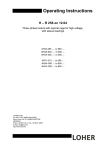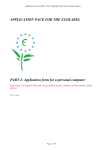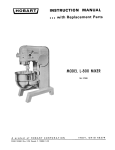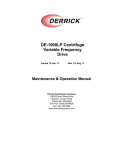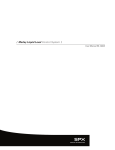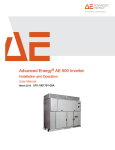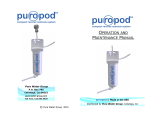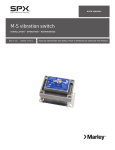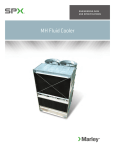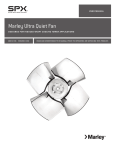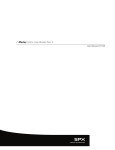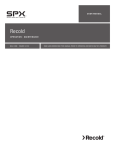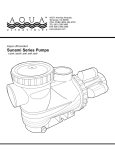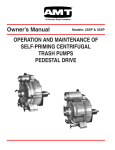Download Marley MH Fluid Cooler Pump User Manual
Transcript
/ Marley MH Fluid Cooler Pump / User Manual 05-1109A Contents Note This manual contains vital information for the proper operation and maintenance of your Marley MH Fluid Cooler Pump. Carefully read the manual before operation and follow all instructions. Save this manual for future reference. Inspection................................................................................................ 3 Handling.................................................................................................. 3 Operation................................................................................................. 3 Maintenance............................................................................................ 5 Mechanical Seal Assembly..................................................................... 6 Mechanical Seal Replacement................................................................ 9 The following defined terms are used throughout this manual to bring attention to the presence of hazards of various risk levels, or to important information concerning the life of the product. Caution Note 2 Indicates presence of a hazard which will or can cause personal injury or property damage if ignored. Indicates special instructions on installation, operation or maintenance which are important but not related to personal injury hazards. Inspection Note Check pump for shortage and damage immediately upon arrival. Note damage or shortage on freight bill (bill of lading); immediately notify your Marley sales representative. EXTERIOR Pay particular attention to conduit box, external hardware and accessories. Touch up abrasions or scratches with approved paint. INTERNAL If extensive or serious external damage is noted, if impeller is damaged (look in ports), or if shaft binds or sticks, disassemble as required to permit internal inspection. Handling Caution Handle with care. Dropping or jarring can seriously damage motor bearings or break pump parts. Lift with device having capacity for pump weight, and use lifting hooks or eye bolts (if provided) or rig double sling around motor frame and pump casing. Do not use sling through pump motor adapter nor around suction and discharge flanges. Operation Pre-Start Before initial start of the pump, check as follows: 1. The rotation must be checked upon installation. Close, then break the contacts quickly and observe the rotation of the exposed portion of the rotating parts. Rotation must agree with the rotation arrow on the motor. For all pumps, the standard rotation is counterclockwise when viewed from the suction end. Motor wiring is easily changed in the field. Observe the wiring diagram on the inside of the terminal box cover, or on the motor nameplate. 2. Check voltage, phase and frequency of line circuit with motor nameplate. 3. Check the suction hood and discharge piping for proper installation. 4. Assure that the collection basin is filled with water to the level indicted in Startup portion of the MH Fluid Cooler User Manual. This water level ensures that the pump is primed. ➠ 3 Operation Caution Do not run pump dry hoping it will self-prime. Serious damage may result if started dry. Starting Proceed as follows to start pump: 1. Prime the pump as outlined in Pre-Start. If pump does not prime properly, or loses prime during start-up, shut down and correct condition before repeating procedure. 2. Start the motor (pump). Running Periodically inspect pump while running, but especially after first start and following repair. 1. Check pump and piping for leaks. Repair immediately. 2. Record voltage, amperage per phase, and kW (if an indicating wattmeter is available). Freezing Protection Protect pumps shut down during freezing conditions by one of the following methods: 1. Drain pump; remove all liquid from the casing. 2. Keep fluid moving in pump and insulate or heat the pump to prevent freezing. If heated, do not let temperature go above 100° to 150°F. 3. Fill pump completely with antifreeze solution. 4 Maintenance Cleaning • Remove oil, dust, dirt, water, chemicals from exterior or motor and pump. • Keep motor air inlet and outlet open. • Blow out interior of open motors with clean compressed air at low pressure. • Regularly drain moisture from TEFC motors. Temperature Total temperature, not the rise, is the measure of safe operation for a motor. If temperature by thermometer exceeds limits for insulation class, investigate and change operating conditions. Labeled Motors It is imperative for repair of a motor with Underwriters’ Laboratories label that original clearances be held; that all plugs, screws, other hardware be fastened securely, and that parts replacements be exact duplicates or approved equals. Violation of any of the above invalidates Underwriters’ label. Lubrication Pumps should require no maintenance. Due to the double shielded prelubricated bearings, no lubrication is required for the life of the bearings. Inspect bearings periodically to determine the condition of the grease and replace the bearings if necessary. ➠ 5 Mechanical Seal Assembly JM FRAME MOTOR A. Disassembly: 1. Turn off power. 2. Drain pump. 3. Remove bolts holding base to foundation 4. Remove pump casing bolts. 5. Remove motor and rotating element from casing, leaving casing and piping undisturbed. 6. Insert a screwdriver in one of the impeller waterway passages and back off the impeller retaining assembly with a socket wrench, as shown in Figure 1. Figure 1 Back off the impeller retaining assembly. 7. Remove impeller from shaft, being careful not to lose the impeller key, spring and seal retainer. If impeller is difficult to remove, it may be neessary to use a bearing puller to pull off impeller. 8. Pry off rotating member of mechanical seal from sleeve by using two (2) screwdrivers. 9. Remove bolts holding adapter to motor and take off adapter. 10. Place adapter on a flat surface with case rabbet facing down, and push out stationary part of mechanical seal. 11. Inspect the shaft sleeve, shaft O-ring and flinger. If damaged or worn, remove and replace with a new one. ➠ 6 Mechanical Seal Assembly Figure 2 Prying off the rotating member. B. Reassembly: Note The mechanical seal is a precision product and should be handled accordingly. Use care when handling the lapped running surfaces of the mechanical seal to ensure they remain clean and free of chips or scratches. 1. Clean gasket and flange faces, seal seat cavity, shaft sleeve, and motor shaft. 2.Lubricate the seal seat cavity of the adapter and the rubber cup or O-ring of seal seat with the lubricating fluid that comes with the mechanical seal or repair kit. Press the stationary seat in seal seat cavity of the adapter squarely and evenly using a arbor press (if possible) and the cardboard disc supplied with the seal. Be certain that the lapped face (shiny side) is facing you. 3. Install the flinger on the motor shaft until it bottoms on the motor shaft. 4. Slide the shaft O-ring on the motor shaft until it is tight against the flinger. Make sure that the shaft O-ring does not get damaged during this procedure. 5. Position shaft sleeve chamfer towards motor and slide on motor shaft. ➠ 7 Mechanical Seal Assembly 6. With motor preferably in vertical position, remount the adapter on motor, making sure the motor shaft does not dislocate or chip the stationery seat of the seal. 7. Apply the lubricating fluid that comes with the mechanical seal or repair kit to the shaft sleeve and the rubber bellows of the rotary seal. Slide the seal head on the sleeve; press the rubber drive band on the rotary head until the lapped face on the head seats firmly against the lapped face of the stationary seat. Do not chip or scratch faces during installation. Take extra care to make sure the lapped faces are clean. Install seal spring on seal head and retainer on spring. 8. Place key in key seat. Line up keyway in impeller with key on motor shaft, and slide impeller on motor shaft. Be certain that the key is positioned in the keyway of the motor and impeller. Slightly compress seal spring with impeller and hold impeller while installing impeller retaining assembly in motor shaft. 9. Insert a screwdriver in a waterway passage of the impeller holding it against rotation and tighten the retaining assembly as discussed in paragraph 7 of disassembly instructions. The impeller will compress the seal spring to the proper length assuring the correct pressure on the lapped surfaces. 10. Remove any burrs caused by screwdriver on the vane of impeller in waterway passage. 11. Slide motor and rotating element in casing. Be sure that any damaged O-ring or gasket is replaced. 12. Tighten casing bolts alternately and evenly. 13. Replace hold-down bolts. 14. Check for free rotation after assembly is completed. 15. Seal all drain openings using pipe sealant on threads. 16. Reprime before starting. Do not start until pump is completely filled with water. 8 Mechanical Seal Replacement C56 FRAME MOTOR A. Disassembly: 1. Refer to “JM FRAME” Disassembly, Notes 1-11. 12.Inspect the stub shaft. If damaged or worn, replace with a new one; removal: A. Drive pin from stub shaft and remove pin. B. Loosen set screws C. Remove stub shaft from motor shaft. Assembly: For motors with drilled hole: A. Slide stub shaft on motor shaft. Line up set screws in stub shaft with motor keyway, and drilled hole in stub shaft with drilled hole in motor shaft. B. Tighten set screws C. Insert #12 drill in pilot hole of stub and motor shaft. Drill out opposite side of stub shaft. D. Install pin For motors without a drilled hole in the motor shaft: A. Slide stub shaft on motor shaft. Line up set screws in stub shaft with keyway in motor shaft. B. Position stub 3 3/32” from Motor C face. (See Figure 3) C. Tighten set screws ➠ Figure 3 Positioning the stub. 9 Mechanical Seal Replacement D. Insert #12 drill in stub shaft pilot hole and drill completely through motor shaft and opposite side of stub shaft. See Figure 4. E. Install pin Figure 4 Positioning the stub. B. Reassembly: Caution The mechanical seal is a precision product and should be handled accordingly. Use care when handling the lapped running surfaces of the mechanical seal to ensure they remain clean and free of chips or scratches. 1. Clean gasket and flange faces, seal seat cavity, and stub shaft. 2. Lubricate the seal seat cavity of the adapter and the rubber cup or O-ring of seal seat with the lubricating fluid that comes with the mechanical seal or repair kit. Press the stationary seat in seal seat cavity of the adapter squarely and evenly using a arbor press (if possible) and the cardboard disc supplied with the seal. Be certain that the lapped face (shiny side) is facing you. 3. With motor preferably in vertical position, remount the adapter on motor, making sure the stub shaft does not dislocate or chip the stationery seat of the seal. 4. Apply the lubricating fluid that comes with the mechanical seal or repair kit to the stub shaft and the rubber bellows of the rotary seal. Slide the seal head on the stub; press the rubber drive band on the rotary head until the lapped face on the head seats firmly against the lapped face ➠ 10 Mechanical Seal Replacement of the stationary seat. Do not chip or scratch faces during installation. Take extra care to make sure the lapped faces are clean. Install seal spring on seal head and retainer on spring. 5. Place key in key seat. Line up keyway in impeller with key on stub shaft, and slide impeller on stub shaft. Be certain that the key is positioned in the keyway of the stub and impeller. Slightly compress seal spring with impeller and hold impeller while installing impeller retaining assembly in stub shaft. 6. Insert a screwdriver in a waterway passage of the impeller holding it against rotation and tighten the retaining assembly as discussed in paragraph 7 of disassemby instructions for JM shaft. The impeller will compress the seal spring to the proper length assuring the correct pressure on the lapped surfaces. 7. Remove any burrs caused by screwdriver on the vane of impeller in waterway passage. 8. Slide motor and rotating element in casing. Be sure that any damaged O-ring or gasket is replaced. 9. Tighten casing bolts alternately and evenly. 10. Replace hold-down bolts. 11. Check for free rotation after assembly is completed. 12. Seal all drain openings using pipe sealant on threads. 13. Reprime before starting. Do not start until pump is completely filled with water. The approved lubricating fluid for seal installation is included with the mechanical seal or repair kit. Caution Do not use other lubricating liquids. We recommend stocking a spare mechanical seal or repair kit to eliminate down time. 11 7401 WEST 129 STREET | OVERLAND PARK, KANSAS 66213 UNITED STATES | 913 664 7400 | [email protected] | spxcooling.com In the interest of technological progress, all products are subject to design and/or material change without notice. ©2008 SPX Cooling Technologies, Inc. | Printed in USA Manual 05-1109A













